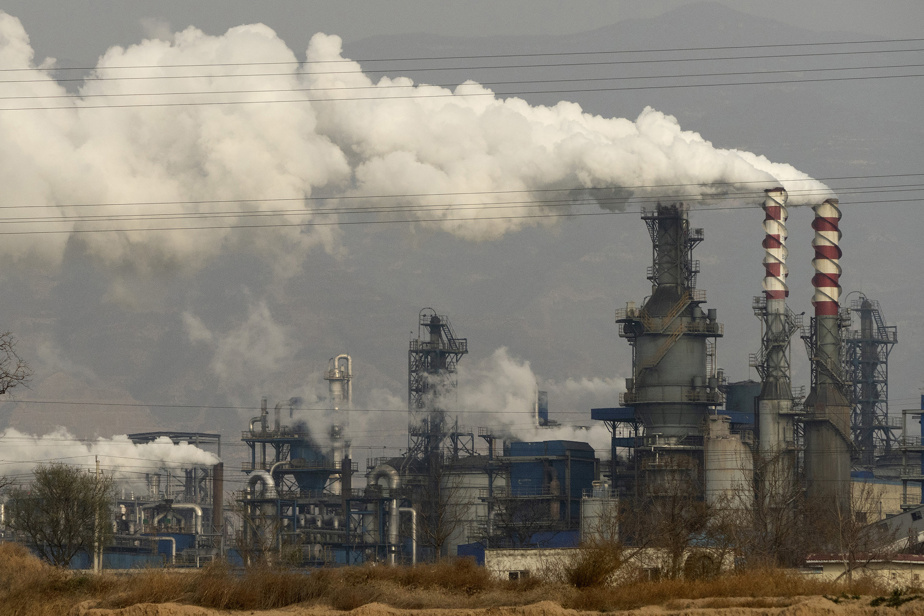Limiting global temperature rise to 1.5°C is still possible if greenhouse gas (GHG) emissions peak by 2025 at the latest, but humanity is not yet on track to do so, warns the Intergovernmental Panel on Climate Change (IPCC). ).
Posted at 11:05 AM
Updated at 11:23 am
Existing emissions must also be halved by 2030 to achieve the goal of the Paris climate agreement, according to the organization’s latest report, released on Monday, which focuses on ways to mitigate global warming.
However, the expected emissions of carbon dioxide (CO2) of existing and currently planned fossil fuel infrastructure exceed the total no-maximum rise to 1.5°C, and instead lead to a 2°C rise, notes the Intergovernmental Panel on Climate Change.
The report somehow asserts that any new project will reduce the chances of limiting warming to 1.5°C; The same goes for the 2°C target.
The report warns that “continuous installation of fossil fuel infrastructure will secure greenhouse gas emissions,” and warns many governments may be tempted to approve new fossil fuel projects.
In Canada, all eyes will inevitably turn to the Minister of Environment and Climate Change, Stephen Gilbolt, who is due to announce by April 13 his decision on the oil development project in the Gulf of Nord, off the coast of Newfoundland.
By 2050, the Intergovernmental Panel on Climate Change has calculated that the equivalent of US$1,000 to 4,000 billion (1,250 to 5,000 billion Canadian) fossil fuels must be left in the earth to limit global warming to 2°C.
Limiting global warming to 2 degrees Celsius or less would leave a significant amount of fossil fuels unburned.
Excerpt from the IPCC report
Required changes
The Intergovernmental Panel on Climate Change is also sounding the alarm against another “lockdown” effect that is harmful to the future: Existing buildings, such as those to be constructed, must compulsorily “close” to carbon neutrality in 2050.
The report states that “unambitious policies increase the risk of closure” that could lead to buildings contributing to greenhouse gas emissions “for decades”.
Significant reductions in the range of 40-70% of global greenhouse gas emissions can be made through “demand-side mitigation” measures, which include for example changes in consumption behaviour, infrastructure use and service provision, says the IPCC.
“Healthy, balanced and sustainable diets,” reducing food waste, incorporating renewable energies into buildings, electrifying transportation, using active and public transportation or using salvageable products that last longer are “lower greenhouse gas density options,” the document says.
Moreover, these measures are “consistent with improving the well-being of all,” as the IPCC defines it.
Accessible options
The IPCC report makes clear that the means to reduce emissions enough to limit global warming to 1.5°C exist and are affordable.
Mitigation options cost $100 ($125 CAD) per tonne of carbon dioxide equivalent (tonne CO2 .).2) could reduce global greenhouse gas emissions by at least half of 2019 levels by 2030,” the report explains.
The report adds that the “economic benefit” of reducing global warming outweighs the cost of mitigation measures.
The report notes that the cost of many low-emissions technologies “has been steadily declining since 2010”.
Opening discussions of the 195 member states on the IPCC report two weeks ago, UN Secretary-General Antonio Guterres said reliance on oil, coal and gas was “crazy”.
We are walking with our eyes closed to the climate catastrophe [et] And if we continue like this, we can say goodbye to the 1.5°C target. A temperature of 2°C can also be elusive. »
IPCC Reports
The report published on Monday is the third and final part of the Sixth Assessment Report of the Intergovernmental Panel on Climate Change, the summary of which will be published next fall. It deals with the mitigation of emissions of greenhouse gases (GHGs) of human origin into the atmosphere. Written by WHO’s Working Group III, which follows Working Group II on the Impacts of Climate Change, Published in February, the first working group looking at scientific indicators of climate change, Posted in August.
read more
-
- +1.1°C
- The current global temperature increase relative to the pre-industrial era
Source: Intergovernmental Panel on Climate Change (IPCC).
- + 2.7°C
- The projected increase in global temperatures based on current commitments by the international community
Source: Intergovernmental Panel on Climate Change (IPCC).

“Extreme twitteraholic. Passionate travel nerd. Hardcore zombie trailblazer. Web fanatic. Evil bacon geek.”



